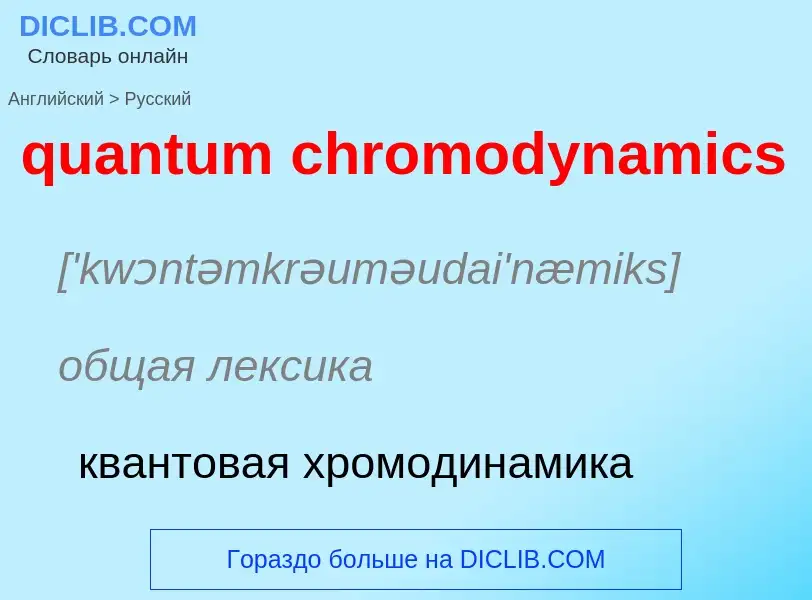Tradução e análise de palavras por inteligência artificial ChatGPT
Nesta página você pode obter uma análise detalhada de uma palavra ou frase, produzida usando a melhor tecnologia de inteligência artificial até o momento:
- como a palavra é usada
- frequência de uso
- é usado com mais frequência na fala oral ou escrita
- opções de tradução de palavras
- exemplos de uso (várias frases com tradução)
- etimologia
quantum chromodynamics - tradução para russo
['kwɔntəmkrəuməudai'næmiks]
общая лексика
квантовая хромодинамика
[krəumə(u)dai'næmiks]
физика
хромодинамика (теория взаимодействий кварков)
существительное
физика
хромодинамика (теория взаимодействий кварков)
физика
хромодинамика квантовая
Definição
Wikipédia
In theoretical physics, quantum chromodynamics (QCD) is the theory of the strong interaction between quarks mediated by gluons. Quarks are fundamental particles that make up composite hadrons such as the proton, neutron and pion. QCD is a type of quantum field theory called a non-abelian gauge theory, with symmetry group SU(3). The QCD analog of electric charge is a property called color. Gluons are the force carriers of the theory, just as photons are for the electromagnetic force in quantum electrodynamics. The theory is an important part of the Standard Model of particle physics. A large body of experimental evidence for QCD has been gathered over the years.
QCD exhibits three salient properties:
- Color confinement. Due to the force between two color charges remaining constant as they are separated, the energy grows until a quark–antiquark pair is spontaneously produced, turning the initial hadron into a pair of hadrons instead of isolating a color charge. Although analytically unproven, color confinement is well established from lattice QCD calculations and decades of experiments.
- Asymptotic freedom, a steady reduction in the strength of interactions between quarks and gluons as the energy scale of those interactions increases (and the corresponding length scale decreases). The asymptotic freedom of QCD was discovered in 1973 by David Gross and Frank Wilczek, and independently by David Politzer in the same year. For this work, all three shared the 2004 Nobel Prize in Physics.
- Chiral symmetry breaking, the spontaneous symmetry breaking of an important global symmetry of quarks, detailed below, with the result of generating masses for hadrons far above the masses of the quarks, and making pseudoscalar mesons exceptionally light. Yoichiro Nambu was awarded the 2008 Nobel Prize in Physics for elucidating the phenomenon, a dozen years before the advent of QCD. Lattice simulations have confirmed all his generic predictions.

